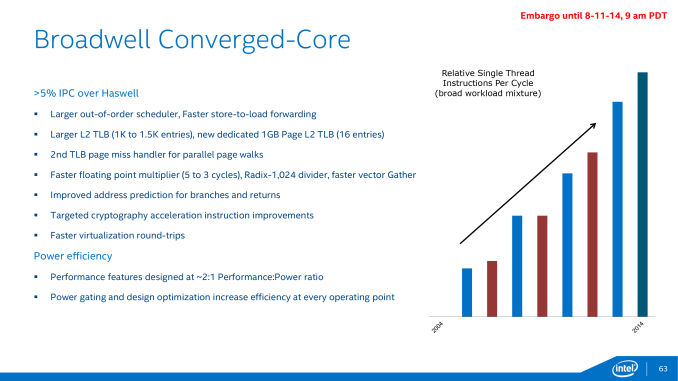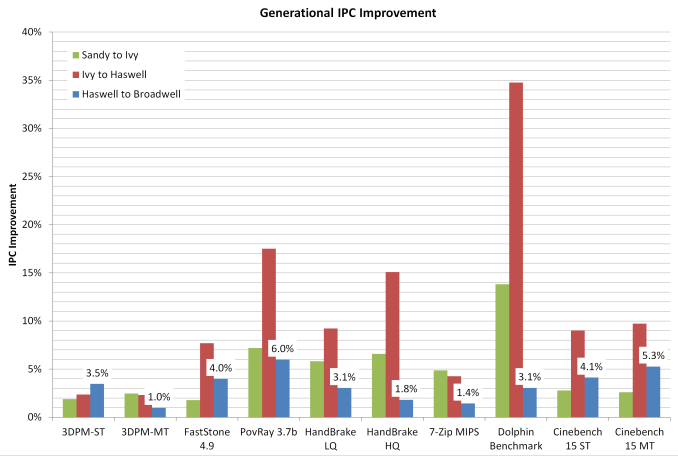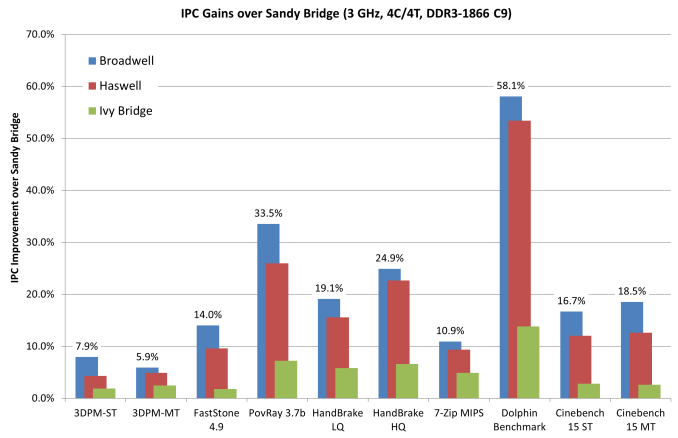The Intel Broadwell Review Part 2: Overclocking, IPC and Generational Analysis
by Ian Cutress on August 3, 2015 8:00 AM ESTConclusions: Broadwell Overclocking, IPC and Generational Gain
For everyone who has been in the PC industry for a decade or more, several key moments stand out when it comes to a better processor in the market. The Core architecture made leaps and bounds over the previous Pentium 4 Prescott debacle, primarily due to a refocus on efficiency over raw frequency. The Sandy Bridge architecture also came with a significant boost, moving the Northbridge on die and simplifying design.
Since then, despite the perseverance of (or soon to be mildly delayed) Moore’s Law, performance is measured differently. Efficiency, core count, integrated SIMD graphics, heterogeneous system architecture and specific instruction sets are now used due to the ever expanding and changing paradigm of user experience. Something that is fast for both compute and graphics, and then also uses near-zero power is the holy-grail in design. But let’s snap back to reality here – software is still designed in code one line at a time. The rate at which those lines are processed, particularly in response driven scenarios, is paramount. This is why the ‘instructions per clock/cycle’ metric, IPC, is still an important aspect of modern day computing.
As the movement from Haswell to Broadwell is a reduction in the lithography node, from 22nm to 14nm, with a few silicon changes, Broadwell was a mobile first design and launched in late 2014 with notebook parts. This is typical with node reductions due to the focus on efficiency overall rather than just performance. For the desktop parts, launched over six months later, we end up with an integrated graphics focused implementation purposefully designed for all-in-one PCs and integrated systems rather than a mainstream, high end processor. The i7 and i5 are both targeted at 65W, rather than 84W/88W of the previous architecture. This gives the CPUs a much lower frequency and without a corresponding IPC change, makes the upgrade path more focused for low end Haswell owners, those who are still several generations behind wanting an upgrade or those who specifically want an integrated graphics solution.
In our first look at Broadwell on the desktop, our recommendation that it would only appeal to those who need the best integrated graphics solution regardless of cost still stands. Part 2 has revealed that clock-for-clock, Broadwell gives 3.3% better performance from our tests although DRAM focused workloads (WinRAR) can benefit up to 25%, although those are few and far between. If we compare it back several generations, that small IPC gain is wiped out by processors like the i7-4790K that overpower the CPU performance in pure frequency or even the i7-4770K which still has a frequency advantage. From an overall CPU performance standpoint out of the box, the i7-5775C sits toe-to-toe with the i7-4770K with an average 1% loss. However, moving the comparison up to the i7-4790K and due to that frequency difference, the Broadwell CPU sits an average 12% behind it, except in those specific tests that can use the eDRAM.
There’s nothing much to be gained with overclocking either. Our i7-5775C CPU made 4.2 GHz, in line with Intel’s expectations for these processors. If we compare that to an overclocked 4.6 GHz i7-4790K, the 4790K is still the winner. Overclocking on these Broadwell CPUs still requires care, due to the arrangement of the CPU under the heatspreader with the added DRAM. We suggest the line method of thermal paste application rather than the large-pea method as a result.
Looking back on the generational improvements since Sandy Bridge is actually rather interesting. I remember using the i7-2600K, overclocking it to 5.0 GHz and remembering how stunned I was at the time. Step forward 4.5 years and we have a direct 21% increase in raw performance per clock, along with the added functionality benefits of faster memory and a chipset that offers a lot more functionality. If you’ve been following the technology industry lately, there is plenty of talk surrounding the upcoming launch of Skylake, an architectural update to Intel’s processor line on 14nm. I can’t wait to see how that performs in relation to the four generations tested in this article.
*When this article was initially published, inaccuracies were made in calculating the IPC gain in the timed benchmarks. The article has been updated to reflect this change. In light of the recalculation,overall conclusions are still correct.
Interesting related links:
The Intel Broadwell Desktop Review: Core i7-5775C and Core i5-5675C Tested (Part 1)
AnandTech Bench CPU Comparison Tool














121 Comments
View All Comments
Oxford Guy - Tuesday, August 4, 2015 - link
No gaming results.TheJian - Monday, August 3, 2015 - link
I was hoping any more coverage of broadwell would include ripping quality comparisons to haswell at least. Is it still fast but crappy, or have they fixed quality so I don't have to keep my gpu off? :( Throw some handbrake tests in please. Quicksync fixed yet?http://www.anandtech.com/show/7007/intels-haswell-...
Any changes since this? Or the review by anand that covered it (linked in there)? Or do we all just hope for a fix with skylake? I saw a recent software update for haswell, but not sure if that does anything about quality here.
Enterprise24 - Tuesday, August 4, 2015 - link
Grid Autosport with 290X show very strange result. I assume this game support AVX2 instruction set ? Since Sandy and Ivy have roughly the same performance. But jump to Haswell gain big improvement.StrangerGuy - Tuesday, August 4, 2015 - link
Yawn...At this point I'm more interested in much better utilisation of hardware through software like DX12 than sinking tens of billions into CPU die shrinks with next to zero real world benefit. The paradox here is of course how the former will make the latter even more irrelevant as it is.lukarak - Tuesday, August 4, 2015 - link
i7-920 waving...Still no reason to upgrade. It was released in 2008, bought it early 2009. and it has been quite sufficient for almost 6.5 years now.
HeJoSpartans - Tuesday, August 4, 2015 - link
Hello Ian,Unfortunately, your IPC increase charts on page 3 of the article reveal several mistakes. The benchmark charts show that the Broadwell chip is not the fastest on both the 3DPM:ST as well as the CBenchR15:MT benchmarks, while your IPC increase charts tell something completely different. Also, some of the other calculated IPC increase values stated in the charts are completely irreproducable on my side. Second, you made a systematic mistake in calculating the IPC increase for the "Lower is better" benchmarks. This is very crucial especially in the Dolphin benchmark, where the total IPC increase from SB to Broadwell would be 58.0% rather than 36.7%. To make this clear: Processor A, that takes half the time for performing a certain task compared to processor B, does not offer a 50% increase in IPC over B, but a total of 100%.
You should re-check your numbers. Hope this helps.
Ian Cutress - Tuesday, August 4, 2015 - link
Hi HeJoSpartans,Somehow the incorrect benchmark result graphs were placed in those spots and they were from the non 3GHz testing - they also had a different z-height. I have updated it - the IPC numbers for those benchmarks in the main graphs are still accurate. For those benchmarks at stock voltage, the balance between frequency and IPC as to which is more important plays out on a larger scale for sure.
Also, with the timed benchmarks. Arguably I actually labelled the axis in terms of Percentage Improvement rather than IPC improvement, despite the title of the benchmark. But you are correct - I mistakenly used the % improvement and the term IPC interchangeably. I have updated the results with a disclaimer.
Any other issues, let me know. I'm also contactable by email if urgent!
-Ian
Navvie - Tuesday, August 4, 2015 - link
No compelling reason to upgrade from my 4770k.Intel needs to get back to working on CPU development rather than GPU.
Speedfriend - Tuesday, August 4, 2015 - link
I have a question. I have seen a article on Intel that speculates that it intends to launch a new chip that has a larger eDRAM (1Gb) and then has 3d Xpoint (15GB) on. The large eDRAM will compensate for the lower write speed of the 3d Xpoint, however the overall chip will offer massive advantages in power consumption and having nonvolatile memory for sleep states. This would be extremely competitive for mobile computing and servers.Given this quote above "Cycling back to our WinRAR test, things look a little different. Ivy Bridge to Haswell gives only a 3.1% difference, but the eDRAM in Broadwell slaps on another 16.6% performance increase, dropping the benchmark from 76.65 seconds to 63.91 seconds. When eDRAM counts, it counts a lot." would that make sense.
The article says that this change in chip design is the reason we are seeing another tock for kaby lake.
Any view from CPU experts on here?
NeilPeartRush - Tuesday, August 4, 2015 - link
1999: Intel Celeron 300A @ 450MHz2003: AMD Athlon XP-M 2200+ @ 2.40GHz
2007: Intel Q6600 @ 3.60GHz
2011: Intel i5-2500K @ 4.8GHz
2015: Skylake?